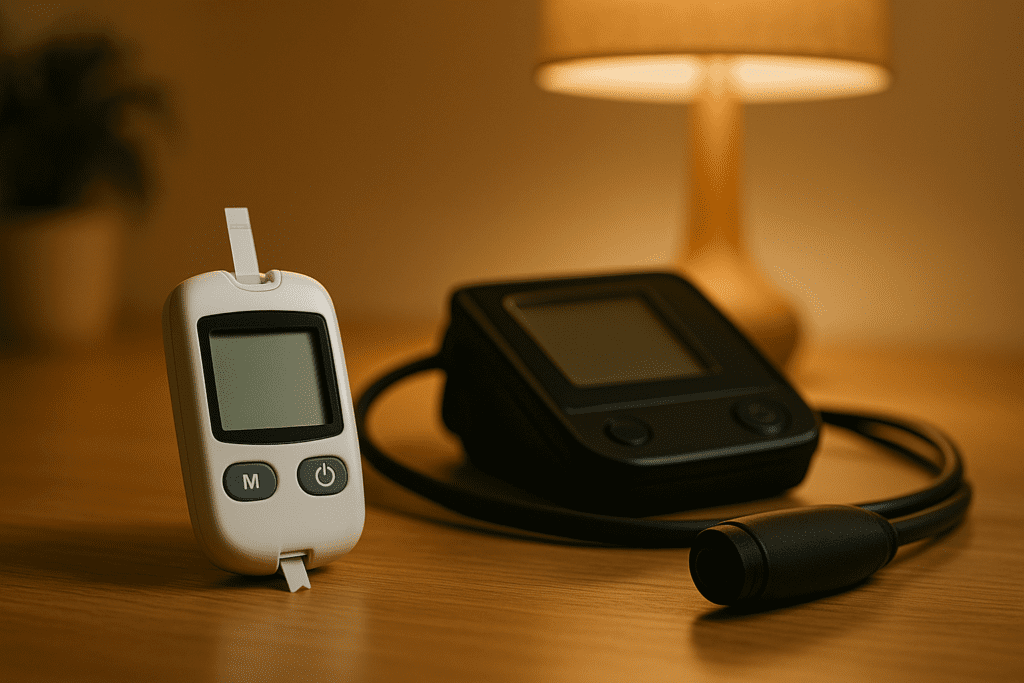The Overlooked Connection Between Glucose and High Blood Pressure
In recent years, scientific interest has intensified around the subtle, yet powerful, interaction between glucose metabolism and blood pressure regulation. For decades, these two systems were viewed largely in isolation—high blood pressure, or hypertension, was seen as a cardiovascular concern, while elevated glucose levels were confined to the domain of diabetes and metabolic health. However, modern research reveals that the relationship between high blood pressure and high sugar levels is far more intertwined than once believed. This overlap holds critical implications for the prevention, diagnosis, and treatment of chronic diseases.
You may also like: How Diabetes Affects the Brain: Understanding Brain Fog, Memory Loss, and Mental Confusion from High Blood Sugar
Both high blood pressure and glucose dysregulation have become increasingly common in modern society, often coexisting in the same individual. This is no coincidence. Each condition can influence the development or progression of the other, and together they may significantly elevate the risk of cardiovascular events, kidney disease, and cognitive decline. The mechanisms linking high blood pressure and glucose levels are complex, involving hormonal pathways, vascular function, inflammation, and the autonomic nervous system. Understanding how glucose and high blood pressure interact provides not only scientific insight but also opens the door to more integrated and effective health strategies.
Recent epidemiological studies have identified that individuals with elevated fasting glucose—even those not meeting the criteria for diabetes—often display higher systolic and diastolic blood pressure. Likewise, those with persistent hypertension tend to show impaired insulin sensitivity, a precursor to elevated blood glucose. Recognizing this bidirectional influence has prompted a shift in how clinicians evaluate and manage both conditions, emphasizing the need for a comprehensive approach rather than isolated treatment targets. In this article, we explore the physiological intersections, clinical evidence, and emerging research that explain how high blood pressure and high sugar levels coexist—and what this means for your long-term health.

How the Body Regulates Blood Pressure and Glucose: A Shared System Under Stress
To understand the interplay between high blood pressure and glucose levels, it’s essential to first grasp how the body regulates each independently—and where their control systems intersect. Blood pressure is regulated by a combination of cardiac output, vascular resistance, kidney function, and neurohormonal signaling. Glucose levels, on the other hand, are maintained through the balance of insulin secretion, insulin sensitivity, glucose uptake, and hepatic glucose production.
These systems are not mutually exclusive. They both rely heavily on the vascular system and are profoundly affected by the health of endothelial cells—the inner lining of blood vessels. When these cells become damaged by chronic inflammation, oxidative stress, or poor diet, both blood pressure regulation and glucose metabolism begin to falter. Insulin, for instance, plays a dual role: it facilitates glucose uptake in muscle and fat cells and also acts as a vasodilator, helping to lower blood pressure. When insulin resistance develops, not only does glucose begin to accumulate in the bloodstream, but the vasodilatory effect of insulin weakens, leading to higher vascular resistance and elevated blood pressure.
Another major point of overlap is the renin-angiotensin-aldosterone system (RAAS), a hormonal system that regulates blood pressure and fluid balance. Chronic activation of the RAAS—common in both hypertensive and insulin-resistant individuals—leads to vasoconstriction and sodium retention. This not only raises blood pressure but also interferes with insulin signaling in cells. In this way, high blood pressure and high sugar levels often emerge from a shared underlying dysfunction, setting the stage for a dangerous cycle of metabolic and cardiovascular stress.
Insulin Resistance: A Central Node Linking Sugar and Pressure
Insulin resistance lies at the heart of the interaction between glucose and high blood pressure. In this state, cells in muscle, liver, and fat tissue fail to respond adequately to insulin, leading to elevated glucose levels and a compensatory rise in insulin secretion. High circulating insulin (hyperinsulinemia) is known to stimulate the sympathetic nervous system, increasing heart rate and vascular tone—two key contributors to high blood pressure.
Moreover, insulin resistance disrupts the normal sodium-handling function of the kidneys. This leads to sodium retention, fluid buildup, and increased blood volume, all of which elevate blood pressure. At the same time, the blood vessels lose their flexibility due to endothelial dysfunction and oxidative stress—two consequences of chronic hyperglycemia and hyperinsulinemia. This combination of impaired vascular function and volume overload forms the pathophysiological backbone of what scientists now recognize as the metabolic syndrome.
The metabolic syndrome—a cluster of conditions that includes abdominal obesity, high blood pressure, elevated glucose levels, and abnormal lipid profiles—is a vivid example of how glucose and high blood pressure often travel together. Individuals with metabolic syndrome face a significantly higher risk of developing type 2 diabetes and cardiovascular disease, and managing one component of the syndrome often yields improvements in the others. For example, interventions that enhance insulin sensitivity—such as weight loss, exercise, or certain medications—not only improve glucose control but often reduce blood pressure as well.
The Role of Chronic Inflammation and Oxidative Stress
One of the most unifying factors connecting high blood pressure and high sugar levels is chronic low-grade inflammation. Inflammatory markers such as C-reactive protein (CRP), interleukin-6 (IL-6), and tumor necrosis factor-alpha (TNF-α) are often elevated in individuals with either or both conditions. These molecules interfere with insulin signaling pathways and promote arterial stiffness, compounding the difficulty in controlling both glucose and blood pressure.
Oxidative stress is another key player. When blood glucose is chronically elevated, it leads to the overproduction of reactive oxygen species (ROS), damaging cells and tissues throughout the body. In the vascular system, this results in reduced nitric oxide availability, impairing the ability of blood vessels to relax and respond to changing demands. The result is persistently elevated blood pressure and increased risk of vascular complications, such as stroke or heart attack. Additionally, oxidative damage within the pancreas can reduce insulin production over time, further worsening hyperglycemia and perpetuating a cycle of metabolic stress.
Interestingly, many of the same dietary and lifestyle factors that increase inflammation and oxidative stress—such as diets high in refined carbohydrates, excessive sodium, low fiber intake, and sedentary behavior—are associated with both hypertension and impaired glucose metabolism. This suggests that lifestyle interventions targeting inflammation may simultaneously benefit both systems, offering a unified strategy for managing glucose and high blood pressure.
The Hidden Dangers of Prehypertension and Prediabetes
A major concern among health professionals is the increasing prevalence of individuals with borderline or subclinical elevations in glucose and blood pressure—categories often referred to as prediabetes and prehypertension. While these states do not meet the diagnostic thresholds for diabetes or hypertension, they are far from benign. Research shows that the combination of slightly elevated blood pressure and glucose levels significantly increases the risk of progressing to full-blown disease, as well as cardiovascular complications.
In fact, some studies suggest that the risk of heart disease in individuals with both prediabetes and prehypertension may be as high—or higher—than in those with diagnosed diabetes or hypertension alone. This highlights the importance of early intervention, even in cases where laboratory values appear only marginally abnormal. Monitoring trends over time, rather than relying solely on cutoffs, may provide a more accurate picture of metabolic and vascular health.
Healthcare providers are beginning to adopt a more nuanced view of these early warning signs, emphasizing the importance of lifestyle modification, dietary counseling, and routine monitoring in individuals who fall within these “gray zones.” Preventing the escalation of both glucose and high blood pressure requires vigilance, especially since the two often amplify one another’s effects over time.
How Glucose and High Blood Pressure Affect the Brain and Kidneys
The relationship between high blood pressure and glucose levels extends beyond the heart and blood vessels to vital organs such as the brain and kidneys. These organs are particularly sensitive to fluctuations in vascular pressure and glucose concentration, and damage can occur silently for years before symptoms arise.
In the kidneys, high blood pressure and high sugar levels work synergistically to damage the delicate network of glomeruli, which filter waste from the blood. Glomerular hyperfiltration—a state driven by excess glucose—is an early sign of kidney strain. When combined with elevated blood pressure, the filtration system becomes overwhelmed, leading to microalbuminuria and eventual chronic kidney disease. Diabetes and hypertension remain the two leading causes of end-stage renal failure, and their combined presence drastically accelerates kidney decline.
In the brain, high glucose and high blood pressure contribute to cognitive decline through multiple mechanisms. Chronic hyperglycemia increases the risk of small-vessel disease, while hypertension damages the blood-brain barrier and impairs cerebral perfusion. These changes are associated with higher rates of vascular dementia and may also contribute to Alzheimer’s disease through mechanisms involving insulin resistance and amyloid plaque formation. Preserving brain health, therefore, necessitates the simultaneous management of both glucose and high blood pressure, especially in aging populations.
Integrated Strategies for Managing Glucose and High Blood Pressure
Given their overlapping mechanisms, an integrated approach to managing high blood pressure and glucose levels is both logical and necessary. Lifestyle modification remains the foundation of any prevention or treatment plan. Regular aerobic exercise improves insulin sensitivity, lowers blood pressure, and reduces inflammation. Strength training adds additional benefits by increasing muscle mass and improving metabolic flexibility.
Dietary interventions are equally powerful. Diets rich in fiber, lean protein, healthy fats, and phytonutrients—such as the Mediterranean or DASH diets—have been shown to reduce both glucose levels and blood pressure. Limiting added sugars and processed carbohydrates can dramatically improve postprandial glucose control, while reducing sodium intake and increasing potassium can lower blood pressure. Importantly, the synergy between these dietary changes often enhances their individual effects.
Pharmacologic treatment may be necessary for individuals with more advanced or resistant conditions. Medications such as ACE inhibitors, ARBs, and SGLT2 inhibitors have shown dual benefits on both blood pressure and glucose control. Moreover, these medications often provide renal and cardiovascular protection, making them ideal choices for patients with coexisting metabolic and hypertensive disorders. The key lies in selecting therapies that address the shared pathophysiology rather than treating each condition in isolation.
The Future of Research and Personalized Treatment
As our understanding of the connection between glucose and high blood pressure deepens, so does the opportunity for innovation in treatment. Future research is focusing on the genetic and molecular markers that predispose individuals to both conditions, with the goal of developing personalized interventions. Advances in wearable technology, continuous glucose monitoring, and home blood pressure devices are enabling more precise and real-time tracking of these interconnected metrics.
Emerging therapies targeting inflammation, oxidative stress, and gut microbiota may further transform the management of these conditions. For example, certain probiotics and prebiotic fibers have demonstrated the ability to improve insulin sensitivity and reduce blood pressure through modulation of microbial metabolites. Nutraceuticals such as berberine, curcumin, and magnesium are also being investigated for their dual effects on metabolic and vascular health.
Ultimately, embracing a personalized, systems-based approach that acknowledges the dynamic interaction between high blood pressure and high sugar levels will allow clinicians to intervene earlier, prevent complications more effectively, and tailor treatments to individual needs. This represents a significant departure from siloed models of care and holds the promise of truly integrative medicine.

Frequently Asked Questions (FAQ): Exploring the Hidden Connections Between Blood Pressure and Blood Sugar
1. Can stress management help regulate both glucose and high blood pressure?
Absolutely. Chronic stress plays a significant role in elevating both glucose and high blood pressure levels due to increased cortisol production. This hormone raises blood sugar for quick energy and constricts blood vessels, which raises blood pressure. Incorporating stress-reduction techniques like mindfulness meditation, progressive muscle relaxation, and even nature therapy can lower both physiological markers. What’s often overlooked is that people under chronic stress may also adopt poor dietary and sleep habits, which further destabilize glucose and high blood pressure control. Managing stress holistically—through psychological therapy, social support, and lifestyle changes—can be a cornerstone of treatment for those managing glucose and high blood pressure simultaneously.
2. Are there specific sleep disorders that affect high blood pressure and glucose levels?
Yes, obstructive sleep apnea (OSA) is a major but underdiagnosed contributor to both high blood pressure and glucose levels. When breathing repeatedly stops during sleep, oxygen levels drop, triggering inflammatory and hormonal cascades that increase insulin resistance and blood pressure. Research shows that untreated OSA can exacerbate both glucose and high blood pressure issues, especially in individuals with metabolic syndrome. Continuous positive airway pressure (CPAP) therapy not only improves sleep but also stabilizes these dual risks. Evaluating sleep quality in patients with both high blood pressure and high sugar levels can reveal root causes not immediately evident in routine exams.
3. How do hormonal fluctuations in women affect high blood pressure and high sugar levels?
Hormonal shifts during menstruation, pregnancy, and menopause can significantly influence high blood pressure and glucose levels. For example, during menopause, declining estrogen levels are associated with reduced insulin sensitivity and vascular stiffness, which can lead to both elevated glucose and high blood pressure. Polycystic ovary syndrome (PCOS) also disrupts hormonal regulation, contributing to insulin resistance and hypertension. What’s often under-communicated is how hormone replacement therapy or birth control pills might further impact these biomarkers. A personalized, hormone-aware approach to managing glucose and high blood pressure is especially vital in female patients.
4. Can certain types of exercise worsen or improve glucose and high blood pressure regulation?
Exercise generally helps control both high blood pressure and high sugar levels, but intensity and timing matter. For instance, moderate aerobic exercise like brisk walking has been shown to reduce both fasting glucose and systolic blood pressure effectively. However, intense anaerobic training or fasted workouts may temporarily spike stress hormones, potentially increasing glucose and high blood pressure levels in some individuals. The key is individualized programming—working with a healthcare provider or exercise physiologist to develop routines that support stable cardiovascular and metabolic function. People with coexisting glucose and high blood pressure issues benefit most from consistent, low-impact workouts rather than sporadic, high-intensity sessions.
5. Are there environmental toxins that impact both high blood pressure and high sugar levels?
Yes, exposure to certain environmental pollutants such as bisphenol A (BPA), phthalates, and heavy metals like lead has been linked to increased risk of glucose dysregulation and high blood pressure. These toxins can interfere with endocrine function and promote systemic inflammation, contributing to insulin resistance and arterial stiffness. Long-term exposure, particularly in industrial or urban areas, can exacerbate chronic conditions tied to both glucose and high blood pressure imbalances. While avoiding all exposure is impossible, using air purifiers, choosing glass over plastic containers, and consuming organic foods where possible may help reduce toxic load. This intersection between environmental health and chronic disease is gaining more attention in preventive medicine.
6. How does gut health influence both high blood pressure and high sugar levels?
The gut microbiome plays a surprisingly powerful role in regulating glucose and high blood pressure. A diverse and balanced microbial population supports efficient nutrient absorption, insulin sensitivity, and even blood vessel function. Dysbiosis—an imbalance in gut bacteria—has been linked to chronic inflammation, which underlies both high blood pressure and high sugar levels. Probiotics, prebiotics, and fiber-rich diets help restore gut health, offering a non-pharmacological way to manage these conditions. Emerging research suggests that personalized microbiome therapy could one day become a standard adjunct in managing both metabolic and cardiovascular diseases.
7. Can cognitive decline be linked to prolonged issues with glucose and high blood pressure?
Yes, persistent issues with high blood pressure and glucose levels have been linked to an increased risk of cognitive decline and even dementia. High sugar levels can damage brain cells and impair memory formation, while prolonged high blood pressure may reduce blood flow to key areas of the brain. This dual impact accelerates neurodegeneration and can manifest as early-onset cognitive impairment. What’s particularly concerning is that this process can begin decades before symptoms become obvious. Therefore, managing glucose and high blood pressure isn’t just about preventing heart attacks—it’s also about preserving long-term brain health and independence in aging populations.
8. Why is morning monitoring important for people with both glucose and high blood pressure concerns?
Morning is often the most volatile time for both blood pressure and glucose levels due to hormonal changes associated with waking. The “dawn phenomenon” can cause blood sugar to rise sharply, while blood pressure tends to peak in the early hours due to circadian rhythms. Monitoring both metrics at home during this time provides a clearer picture of baseline risk and medication effectiveness. It also allows early intervention if either glucose or high blood pressure is trending dangerously upward. Using smart devices that sync with apps can help track these dual metrics and uncover patterns that standard lab work might miss.
9. Are there mental health conditions that worsen glucose and high blood pressure outcomes?
Yes, depression and anxiety disorders are strongly associated with worse outcomes in people managing high blood pressure and glucose levels. These mental health conditions can interfere with medication adherence, sleep, diet, and physical activity—all critical factors in chronic disease management. Furthermore, stress hormones like cortisol and adrenaline not only elevate blood sugar and blood pressure but also exacerbate mood disorders, creating a vicious cycle. Integrated care models that treat mental and physical health together have shown promise in improving outcomes. Ignoring the psychological dimensions of high blood pressure and high sugar levels is a missed opportunity in comprehensive care.
10. What are future innovations in managing glucose and high blood pressure together?
The future holds promising innovations for simultaneously managing glucose and high blood pressure, including AI-driven diagnostics, continuous monitoring biosensors, and precision medicine based on genomics. Devices are now being developed that can monitor both blood glucose and blood pressure in real-time, offering personalized alerts and data analytics. On the pharmaceutical side, combination therapies that address both glucose and high blood pressure with fewer side effects are in the pipeline. Nutritional genomics may soon allow diet plans tailored to an individual’s genetic makeup, optimizing how they metabolize sugar and sodium. These developments signal a shift toward more proactive, individualized care that addresses the root causes of metabolic and cardiovascular dysfunction.

Conclusion: Understanding the Overlap Between High Blood Pressure and High Sugar Levels Is Key to Long-Term Health
The intricate relationship between glucose and high blood pressure challenges traditional notions of disease classification and underscores the need for holistic health strategies. Rather than treating elevated blood pressure and sugar as separate, unrelated issues, science increasingly supports the view that they are manifestations of a shared underlying dysfunction. High blood pressure and high sugar levels often arise from the same environmental, behavioral, and genetic roots, and their coexistence significantly elevates the risk of chronic disease.
Recognizing this connection is not just an academic exercise—it has profound implications for public health, clinical practice, and personal wellness. By targeting inflammation, insulin resistance, vascular health, and lifestyle patterns, we can make meaningful strides in preventing and managing these prevalent conditions. For anyone navigating the challenges of metabolic health, understanding how glucose and high blood pressure interact is not only enlightening but potentially lifesaving.
In this rapidly evolving field, continued research and public awareness will play a vital role in shaping future approaches. As science reveals more about the interplay between high blood pressure and glucose levels, it becomes increasingly clear that comprehensive, integrated care is the path forward. The time has come to break down the artificial barriers between metabolic and cardiovascular medicine and embrace a unified model that treats the whole person—not just isolated numbers on a chart.
metabolic syndrome risks, insulin resistance and hypertension, cardiovascular effects of high glucose, oxidative stress and vascular damage, kidney disease from high blood sugar, endothelial dysfunction and blood pressure, glucose and brain health, sugar-induced inflammation, dietary strategies for blood pressure and sugar, DASH diet for metabolic health, Mediterranean diet for insulin control, RAAS and insulin resistance, nitric oxide and blood flow, sugar metabolism and vascular health, chronic inflammation and hypertension, SGLT2 inhibitors and blood pressure, probiotics for metabolic health, ACE inhibitors and glucose levels, personalized metabolic care, early warning signs of metabolic disease
Further Reading:
The link between diabetes and hypertension
Diabetes, Hypertension, and Cardiovascular Disease: Clinical Insights and Vascular Mechanisms
Disclaimer: The content published on Better Nutrition News (https://betternutritionnews.com) is for informational and educational purposes only. It is not intended as a substitute for professional medical advice, diagnosis, or treatment. Always seek the guidance of a qualified healthcare professional before making any changes to your diet, nutrition, or wellness practices. The opinions expressed by authors and contributors are their own and do not necessarily reflect those of Better Nutrition News.
Better Nutrition News and its affiliates make no representations or warranties regarding the accuracy, completeness, or reliability of the information provided. We disclaim all liability for any loss, injury, or damage resulting from the use or reliance on the content published on this site. External links are provided for reference purposes only and do not imply endorsement.



